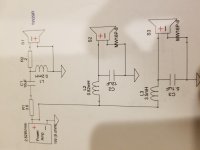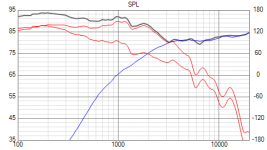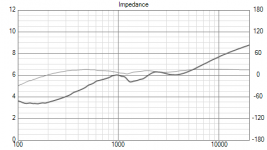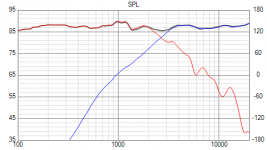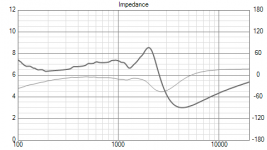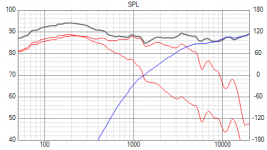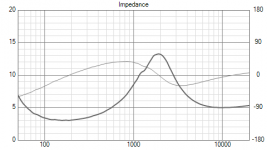Hi All,
I just put together a new speaker and I am not happy with the midrange sound, a bit sharp, harsh or strong sounding. I prefer a more relaxed sound. I know the drivers are good quality so it is probably my implementation. It is a 2 1/2 way using 2 MW16P-8 and a TW29R in a vented cabinet tuned to 43hz and I am going to try to attach a schematic. My system electronics are all very hi end so I don't suspect the source. The speaker is run full range with a sub. Thank you in advance for your assistance.
I just put together a new speaker and I am not happy with the midrange sound, a bit sharp, harsh or strong sounding. I prefer a more relaxed sound. I know the drivers are good quality so it is probably my implementation. It is a 2 1/2 way using 2 MW16P-8 and a TW29R in a vented cabinet tuned to 43hz and I am going to try to attach a schematic. My system electronics are all very hi end so I don't suspect the source. The speaker is run full range with a sub. Thank you in advance for your assistance.
Attachments
I quickly simulated your design and with two MW16P's, the midrange from around 100hz to 2Khz is about 6db higher than the tweeter.
On your diagram try disconnecting speaker S3 and bypass R1 from your tweeter crossover and see if that reduces the midrange harshness.
Removing one MW16P and bypassing R1 will match the audio levels.
The only downside is bypassing R1 is it drops the speaker impedance to approx 3ohms at 4.5khz.
You could also try changing R1 to 1ohm and bypass R2, this will bring the impedance up to around 4ohms but will increase the audio from 7khz upwards.
This is based on simulated data from the driver datasheets.
See the attached images of the before (original) and after with the changes.
On your diagram try disconnecting speaker S3 and bypass R1 from your tweeter crossover and see if that reduces the midrange harshness.
Removing one MW16P and bypassing R1 will match the audio levels.
The only downside is bypassing R1 is it drops the speaker impedance to approx 3ohms at 4.5khz.
You could also try changing R1 to 1ohm and bypass R2, this will bring the impedance up to around 4ohms but will increase the audio from 7khz upwards.
This is based on simulated data from the driver datasheets.
See the attached images of the before (original) and after with the changes.
Attachments
This is very similar to SB Acoustics' Rinjani kit - same drivers and basically the same crossover configuration, though different values.
The Q of your upper midwoofer filter is much too high (about 1), meaning that you are creating a resonance. You need to reduce the value of the capacitor. Furthermore, your lower midwoofer contributes too much in the midrange (your filter Q is low here but the electrical crossover point is quite high). The problem is the small value capacitor - it needs to be larger. You are also attenuation the tweeter more than your probably should (which tells me that maybe your are optimizing the on-axis response rather than going a little off-axis - on-axis is more in your face) and the value of the capacitor is maybe a little too high. Finally, the port tuning frequency is quite high, which can also contribute to a more resonant sound character.
Is your baffle inclined or do you have the tweeter offset? Only this way, the 2nd order network on the tweeter will work really well.
For reference, the Rinjani is not meant to be toed in - it sounds sweeter off-axis.
The Q of your upper midwoofer filter is much too high (about 1), meaning that you are creating a resonance. You need to reduce the value of the capacitor. Furthermore, your lower midwoofer contributes too much in the midrange (your filter Q is low here but the electrical crossover point is quite high). The problem is the small value capacitor - it needs to be larger. You are also attenuation the tweeter more than your probably should (which tells me that maybe your are optimizing the on-axis response rather than going a little off-axis - on-axis is more in your face) and the value of the capacitor is maybe a little too high. Finally, the port tuning frequency is quite high, which can also contribute to a more resonant sound character.
Is your baffle inclined or do you have the tweeter offset? Only this way, the 2nd order network on the tweeter will work really well.
For reference, the Rinjani is not meant to be toed in - it sounds sweeter off-axis.
Thanks to the info from USXX, I quickly simulated the Rinjani kit and it gets near enough to the frequency response in SB Acoustics Kit manual.
See the attached SPL response.
See the attached SPL response.
Attachments
Last edited:
I did a quick simulation using VituixCAD, basically just tracing the frequency response curves from datasheets or the like. Obviously its more accurate if you use data from actual measurements, but for quick simulations tracing curves gives you some idea if you're in the ballpark.
You can do the same thing with Xsim, with VituixCAD you can actually model the woofers in a box and simulate baffle diffraction.
Both these tools have active threads in the software tools section.
You can do the same thing with Xsim, with VituixCAD you can actually model the woofers in a box and simulate baffle diffraction.
Both these tools have active threads in the software tools section.
USXX how do I figure out the Q of the XO sections? I assume a q of 0.7 is desirable.
I did change the values in one speaker and it seems to help but I did not have a lot of extra caps around so the 5 uf was replaced with a 33uf (probably too much) and the 12uf was replaced with a 4uf possible too little?
I didn't know the optimized values, just a quick change to see the effect.
I did change the values in one speaker and it seems to help but I did not have a lot of extra caps around so the 5 uf was replaced with a 33uf (probably too much) and the 12uf was replaced with a 4uf possible too little?
I didn't know the optimized values, just a quick change to see the effect.
Have you got any measurements, by a chance? You can connect the second woofer part after the first inductor (account for change in impedance) so you use a smaller inductor on the 0.5 woofer.
yea it drops to about 1.5mh
USXX how do I figure out the Q of the XO sections? I assume a q of 0.7 is desirable.
Assuming a resistive load (R),
Q = 2*pi*fc*C*R
fc is the electrical crossover frequency (i.e. the natural frequency of the 2nd order filter), which is not exactly the same as the acoustic crossover frequency you are going to end up with.
fc = 1/(2*pi*sqrt(L*C))
Units: L [H], C [F]
You don't aim for a specific Q-value but you certainly want to keep it below 0.7 in this case. Use it as a guideline.
The exact same equations apply for a 2nd order high-pass filter, though if you have a resistor in front of the capacitor, the equation for the Q-factor will change.
OK so Ive changed out some parts and it does sound better. I think the one area where i can improve is the second woofer. I have a 3.5mh and 33uf on it. That works out to about a 500hz XO. I think it should be lower around 350hz closer to the baffle step. What are your thoughts on that. I would go with a 4.5 mh coil.
Yeah, normally want the XO to be a part of BSC and dialing this in before messing with the HF, so while a good plan to do it with the correct components/simming program, using L-pads to get close [if not spot on] with one's ears is a better plan and what I always recommend with dialing in horn systems, especially with two ways, since to get the HF right with a by-pass cap/whatever requires accurately first finding how fast and where, the horn proper is rolling off without tedious measurements.
GM
GM
when you say harshness, what particular tracks or instruments are harsh / strident?
I ask, since I've found the ELC range of ~ 2Khz- 5 Khz is where I am most sensitive (and listening fatigue over a longer session).
In this case, I wouldn't rule out the tweeter being a contributor and needing some padding or a high XO point to create the infamous BBC dip.
A sine wave sweep can help - focussing on the prominent frequencies.
I also use a multi-adjustable PC based EQ - to tune the target slope on a number of tracks (voice I suppose). Such that great recordings lose no obvious balance or detail and harsh recordings are listenable.
I ask, since I've found the ELC range of ~ 2Khz- 5 Khz is where I am most sensitive (and listening fatigue over a longer session).
In this case, I wouldn't rule out the tweeter being a contributor and needing some padding or a high XO point to create the infamous BBC dip.
A sine wave sweep can help - focussing on the prominent frequencies.
I also use a multi-adjustable PC based EQ - to tune the target slope on a number of tracks (voice I suppose). Such that great recordings lose no obvious balance or detail and harsh recordings are listenable.
Hey Dave we're thinking alike, see my comments:
Thanks I am noticing that my sims are not that close to my actuals. The sims show a BBC dip but in reality it is ruler flat.
when you say harshness, what particular tracks or instruments are harsh / strident? <didn't pay particular attention as I zipped through selections pretty quickly but I would say horns and higher range vocals>
I ask, since I've found the ELC range of ~ 2Khz- 5 Khz is where I am most sensitive (and listening fatigue over a longer session). <agree>
In this case, I wouldn't rule out the tweeter being a contributor and needing some padding or a high XO point to create the infamous BBC dip. <I changed the cap on the tweeter from a 15uf to a 10 uf and it helped. I like the BBC dip>
A sine wave sweep can help - focussing on the prominent frequencies. <weird but the sweeps are ruler flat>
I also use a multi-adjustable PC based EQ - to tune the target slope on a number of tracks (voice I suppose). Such that great recordings lose no obvious balance or detail and harsh recordings are listenable.
Thanks I am noticing that my sims are not that close to my actuals. The sims show a BBC dip but in reality it is ruler flat.
OK so i have tried many different variations of crossover and even tried duplicating other established designs. I just can't get used to the sound of the MW16P. Sounds very peaky and brutally non forgiving. My source equipment is decent stuff so I am wondering if anyone else has experienced the same thing.
Hi Jim, the Satori MW16P-8 is a low distortion driver across the mid range of frequencies, particularly low in the 3rd harmonic which should present itself as clear and clean.
Satori MW16P-8 | HiFiCompass
Satori TW29R | HiFiCompass
By the way what's the baffle width of your enclosure ? You may be getting a diffraction peak corresponding with a resonant peak in the response ?
C.M
Satori MW16P-8 | HiFiCompass
Satori TW29R | HiFiCompass
By the way what's the baffle width of your enclosure ? You may be getting a diffraction peak corresponding with a resonant peak in the response ?
C.M
Last edited:
- Status
- This old topic is closed. If you want to reopen this topic, contact a moderator using the "Report Post" button.
- Home
- Loudspeakers
- Multi-Way
- Assistance with cause of Harshness
